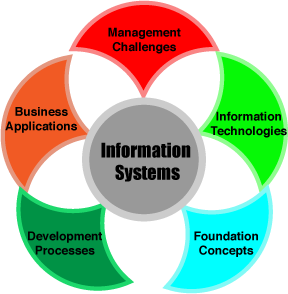05 – Information Systems no comments
Information Systems
O’brien (2007) defines an Information system (IS) as any kind of organized combination of people, hardware, software, communications network, data resources, and policies and procedures that stores, retrieves, transforms, and disseminates information in an organization.
The Framework.
There are 5 main areas that build the framework for the information systems. All these elements play an important role in the process of building the research project.

Foundation Concepts
To develop an information system, it is important to understand the behavioral, technical, business and managerial elements in order to develop the components for the Information System.
Information Technologies
In this area we will focus on the hardware, software, networks and data management that will affect the project in regard of its development, concept development and management.
Business Applications
Concepts like e-commerce can influence or provide ways of how the management can be implemented in an Information System like the one required for the Museum application.
Developments Processes
This will be focusing on the planning, development and implementation of the system(s) to meet the requirements of the problem or situation.
Management Challenges
Through this process, we will focus on delivering and managing effectively the information technologies at the end-user, business or int this case a multiuser/global institution.
Inside Management Systems
There are several types of Information Systems. They are usually classified into two different groups: Operations Support Systems and Management Support Systems.
Operation Support Systems:
- Specialized Processing Systems
- Transaction Processing Systems
- Process Control Systems
- Enterprise Collaboration Systems
Management Support Systems:
- Management Information Systems
- Decision Support Systems
- Executive Information Systems
- Specialized Processing Systems
There are five major resources focusing on the relationship with the IS and the products (O’brien, 2007)
- People Resources
- Specialists – software developers or system operators
- End Users – the person who uses the IS
- Hardware Resources
- Machines – computers, monitors, drives, printers or scanners
- Media – Storage, disks or paper forms
- Software Resources
- Programs – operating systems, editors or payroll applications
- Procedures – data entry procedures, error correction, paycheck distribution procedures
- Data Resources
- Communication media, communication processors, network access, control software
- Information Products
- Management reports, business visual display and paper forms
All these elements and areas can help us to visualize the complexity of the development of an Information System. We need to know what do we want from the organisation (system) to do? An organisation that includes people is more complex to manage than one that doesn’t (Wilson, 2001). For this, it is important to analyse the system implemented. Users or a human response will vary which will vary the judgement of the system.
To avoid judging problems we have to follow a specific methodology. We have to define a problem first of all. From here we can start gathering the appropriate techniques to solve this problem. The implementation or application of these techniques will allow us to go to the next step if effective or back to the previous one if unsuccessful. We also have to analyse the cost/effective solution. After these steps we can finally implement the solution.
So we have to solve a problem. But, who is defining the problem. What seems to be problematic for one person can not appar to be so for another one. Wilson (2001) explains that instead of focusing on a person’s problem or a problem, we have to focus on defining a situation that is problematic. I believe this will help the project not to isolate on a single person’s perspective.
Bibliography
O’BRIEN, J. A. & MARAKAS, G. M. 2007. Introduction to information systems, Boston, Mass., McGraw-Hill.
WILSON, B. B. 2001. Soft systems methodology conceptual model building and its contribution, Chichester ;, Wiley,.